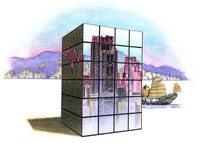When Severe Acute Respiratory Syndrome (SARS) broke out in Hong Kong in 2003, some media outlets predicted economic calamity for the city. But by one financial measure — real estate prices — Hong Kong hardly suffered, according to research by Grace Wong, a Wharton real estate professor.
Wong has found that Hong Kong housing prices dropped only 1.6% during the three-month epidemic and the six months afterwards. Even housing complexes where SARS victims lived saw only a 3% dip in their value, on average. Hong Kong residents did slow their home purchases and sales — Wong documented a decline in housing turnover — but they didn’t bail out of the market. Rather than panicking, they seemed to have waited to see what would happen.
Their prudence proved prescient. In June 2003, the World Health Organization (WHO) officially declared that the epidemic had ended in the city. The flu-like illness had subsided as abruptly as it had struck.
As Wong points out in her paper titled, “Has SARS Infected the Property Market? Evidence from Hong Kong,” SARS had reached Hong Kong in March 2003 and was the “first new serious, contagious illness of the 21st century.” It had surfaced a few months earlier in China’s Guangdong province. Scientists eventually traced it to the region’s teeming wild-game markets, where the virus seems to have jumped from animals to humans. According to the WHO, an infected doctor unknowingly carried the disease from Guangdong to Hong Kong. SARS would eventually reach 30 countries, but among major cities, it hit Hong Kong the hardest. By the time the WHO had declared the epidemic done there, 1,755 people in the city had taken ill, and 300 of them had died. In one housing complex, Amoy Gardens, SARS infected 329 people.
Epidemics have traditionally been seen as the province of physicians and epidemiologists, not economists like Wong. But in a global economy, diseases will likely spread farther and faster, as people jump on and off planes to do business in places as far-flung as Singapore and Sweden. “[SARS] illustrates the type of low-risk, high-cost threat of infectious disease that is expected to become increasingly common in a more integrated world economy,” Wong points out in a related research paper, “Is SARS a Poor Man’s Disease? Socioeconomic Status and Risk Factors for SARS Transmission.”
Witness mad-cow disease. Though it hasn’t become an epidemic among humans, an outbreak among British cattle in the 1990s hobbled England’s beef industry as other European countries closed their borders to imports of British beef. Or consider avian flu, which began in China and has flown via infected fowl through Asia to Turkey. It may end up doing far greater damage than SARS if the virus that causes it mutates and begins jumping from person to person. So far, victims seem to have contracted the illness only through contact with infected birds. But some scientists predict that the virulent flu strain — it has killed more than half of the nearly 200 people who have contracted it, compared with about 10% for SARS worldwide — has the potential to rival the Spanish Flu of 1918, which killed an estimated 40 million people, if it mutates into a human-communicable form.
Numbers like these are scary, and viruses defy nonprofessionals’ understanding, mainly because they are invisible and unpredictable. As a result, “societal responses to health risks tend to be extreme and inconsistent, suggesting an overestimation of the frequency of rare risks,” Wong writes. In other words, people panic. And that’s what Wong expected to find when she studied Hong Kong’s housing market in the wake of SARS. Real-estate prices already had been falling there, but some commentators blamed a sharp slide during the epidemic on the disease. Wong’s statistical analysis allowed her to tease out the effect of SARS and conclude that “the frequently cited 8% drop in the housing price index from March to June 2003 was largely due to historical trends.”
Why didn’t people sell their homes and flee Hong Kong? Wong sees a financial explanation: “There is reason to believe that cognitive errors in judgment are less likely when the costs to the decision maker are high. Housing sale prices are likely to have a significant impact on household wealth positions, especially for leveraged households.”
Some people simply may not have been able to afford a move. As the value of their residences dropped, they lost some of their potential down payment for a new place. Others may have chosen not to sell for fear of losing money during what they hoped would be a temporary emergency. “Given the importance of housing in the average Hong Kong household wealth portfolio, it is perhaps not surprising that the market adopted a cautious wait-and-see attitude in response to the SARS epidemic, without showing significant signs of overreaction,” she concludes.
The Income-SARS Correlation
Besides examining SARS’ impact on real-estate values, Wong also explored the role of income in determining whom the disease struck. She found a strong link between earnings — or rather the lack of them — and the likelihood of catching SARS. Simply put, the poorer someone was, the more likely he or she was to get sick.
That, in itself, isn’t surprising. Epidemiologists have long tied the incidence and severity of many diseases at least partly to poverty. Poor people tend to have less access to healthcare in general and preventive care in particular. And lack of nutrition can contribute to their susceptibility to illnesses. Compare, for example, the state of the AIDS epidemics in Africa and the United States. In poverty-ridden Africa, the disease remains a death sentence while in the United States, it has become a serious, but manageable, chronic condition.
Wong was able to add to the traditional insights on the role of income by collecting data on Hong Kong’s housing market. She tied the incidence of SARS not only to socioeconomic status but also to the sorts of places where victims lived. “Even when controlling for all relevant measures of housing conditions, the income-SARS correlation remains robust,” she argues.
Her most surprising finding was that education seemed to have no link to whether a person caught SARS. As a rule, the more educated people are, the wealthier they are, she points out. “We also tend to think that education helps because educated people would adopt the right practices. Maybe education didn’t play a part because Hong Kong had a really good public-education campaign. There was loads of information out there.” Public-service ads encouraged people to wash their hands frequently and wear surgical masks. The government also took steps to try to stem the spread of the disease, closing schools and requiring that elevators be cleaned regularly.
According to Wong’s research, the elevator rule in particular made sense. She found that buildings with a higher number of floors tended to have more SARS cases. In one of her papers, she attributes that to “environmental contamination (e.g., elevators) and a meeting-point effect.” That same effect seems to explain why residences with health clubs and child-care centers saw higher SARS rates, she notes. During the epidemic, people may have stayed closer to home, opting to use facilities within their building, rather than those outside. If their neighbors hadn’t contracted the disease, doing that would have protected them. But if they had, it could have exacerbated the spread. Similarly, housing complexes with higher proportions of students and workers using public transit saw more SARS cases. Viruses love crowds.
Yet Wong also discovered that some housing characteristics that would seem to increase residents’ susceptibility had no effect on whether people caught SARS. Crowded households were no more likely to catch the disease than less crowded ones, and complexes near healthcare providers were no more likely to be infected than distant ones. Two complex qualities that at least hint at the economic status of residents — building age or whether a complex is public or private — showed no clear connection to incidence rate, either.
Wong also examined whether employment had any role in who caught SARS. There, her results weren’t surprising: Service workers were most likely to get sick, followed by professionals. “Likely explanations include the workers’ high contact rate with the general population, and thus SARS cases, and the likely proximity of shops and other places where the public convene and the disease spreads,” she notes. “Part of the link between SARS incidence and the share of the workforce who are professionals [might] be due to the inclusion of healthcare workers and other client-based professionals, such as consultants, in the category.”
Wong brought an unusual personal connection to this research. She is from Hong Kong and still has family there. During the epidemic, she spoke with her relatives regularly and shared their fear. “My sister was taking the bus everyday to work, and you never knew where the next case was going to come from,” she recalls. “They were saying it was all happening in the poorer areas, but that wasn’t so obvious at the time.”
Wong returned home for a visit in February 2004, eight months after the WHO had declared the epidemic over. She found that people in Hong Kong, though they had not panicked, had changed their practices. “Masks have become a more permanent part of society,” she says. “That’s definitely post-SARS.” Hong Kong has long been a place where people worry about the spread of disease and where a few people wore masks in the street, she says. “During SARS, people realized that the mask was quite useful. Because of the epidemic, people wearing them don’t look like freaks anymore.”



